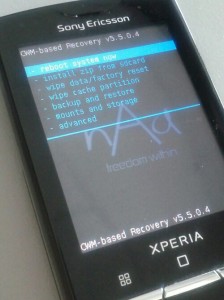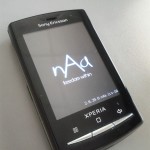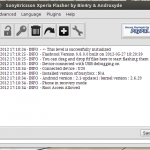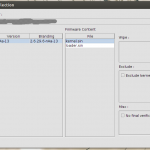ICS on Sony Ericsson Xperia X10 Mini Pro!
Let’s be honest: starting from zero it’s a huge process, but it’s possible.
This procedure is a bit complicated and needs some skills.
I can do (and I did) almost everything from GNU/Linux.
Prerequisites (my starting point)
- a full backup done: you’ll lose your phone data
- the phone must run the stock image.
Latest 2.1.1.A.0.6 SE firmware is required for bootloader unlocking procedure.
If you are running an unofficial ROM, you can check my preferred way to restore stock ROM. Firmware 2.1.1.C.0.0 is reported to work, too, but I can’t confirm it - phone must run baseband M76XX-TSNCJOLYM-53404015
- a pc running Ubuntu Linux 12.04 64bit (32bit is reported to work too)
- adb installed and runnable from the pc
- standard USB cable
All needed software
- FlashTool
I used flashtool-0.8.0.0-linux.tar.7z
You can find this tool on its official page http://androxyde.github.com/Flashtool/ - msm7227.7z, see xda forum for download links
- a bash script I wrote to run msm7227 from GNU/Linux. Download here
- kernel image
I used U20_nAa-ics-04_2.6.29.6-nAa-ics-04.ftf
Download links on Google Code official pages. Kernel file names for our device start with “U20” string and they contain “ics” string as well - MiniCM9 ROM
I used MiniCM9-3.0.3-mimmi.zip
Download links on Google Code official pages. Be carefull, we have a device with codename “mimmi” - Google Apps (also known as gapps)
I used gapps-ics-20120317-signed.zip
You can find download links on goo.im official pages. Pick gapps for “ics”
What you’ll get
A super clean phone (no data and crappy bloatware).
One of the most recent mobile operating system: Android Ice Cream Sandwich.
All the goodies provided by CyanogenMod: the ROM I installed is MiniCM9.
Everything working great: camera, wifi etc. (I admit I have to check tethering…).
Disclaimer
BASIC COMPUTER SKILLS REQUIRED.
PROCEED WITH CAUTION.
The instructions are provided only to show how reached my goal.
Please follow them at your own risk. Stop if you are not in my same situation.
Procedure summary
We have basically 3 things to do:
- unlock bootloader
- install custom kernel (suitable for ICS)
- install ICS ROM + Google Apps
Without an unlocked bootloader, you can’t install a custom kernel.
Without a custom kernel, you can’t install ICS.
0. Copy needed files on the phone
As pointed out by Fabian in his comment, it’s safer to copy the files you’ll use at the end of the procedure when your phone is still fully functional.
So, connect the device to your pc, use it as an external storage and copy these files on the sdcard
- MiniCM9-3.0.3-mimmi.zip
- gapps-ics-20120317-signed.zip
1. Unlock bootloader
I presume you’re starting from the very beginning, so I think you have a locked bootloader.
To fix this situation you’ll need some software:
- msm7227.7z
- my script: msm7227_semc.sh
This is the most difficult and dangerous step. The risk is that the phone get bricked. Be careful.
Probably you should read the full story here. There are reported some incompatible situations. If you have never unlocked your bootloader, probably you can go on as I did.
The software you downloaded is written for Windows types of operating systems.
I rewrote the cmd script and made a bash script.
Many kudos to xda forum user “the_laser”, I just translated his work.
You have to follow these steps:
- unpack archive in a new folder
$ 7z x -omsm7227 msm7227.7z - uncompress and copy my script in the same folder
$ mv msm7227_semc.sh msm7227/ - connect the phone to an USB port
- enable debug USB on the phone itself
- run the script
$ cd msm7227/see my output
$ ./msm7227_semc.sh
2. Install custom kernel
You have successfully unlocked your bootloader and now you can now install a custom kernel.
You’ll need flashtool utility and the ftf image file containing the kernel to flash and the recovery software.
- FlashTool
- kernel image file
Follow these steps:
- uncompress and untar flashtool
$ 7z x -oflashtool flashtool-0.8.0.0-linux.tar.7z
$ tar -C flashtool -xf flashtool/FlashTool-0.8.0.0-linux.tar
$ rm flashtool/FlashTool-0.8.0.0-linux.tar - launch FlashTool, it’s a java tool with a simple GUI
- drag on the main window the ftf file
- follow the instructions
- at the end the program will tell you that the phone will reboot. It’s not true, so disconnect the USB cable
- wait 5 seconds
- boot the phone and repeatly push the back button to enter recovery menu.
ClockworkMod must be installed and should come up.
You must see nAa kernel logo.
if CWM menu doesn’t appear you must retry with a reboot (at the moment the phone is unusable)
If you find yourself in troubles, keep in mind that everything can be repaired with a full system restore through SEUS.
3. Install MiniCM9 and the Google Apps
We are almost at the end.
At this time you have an useless phone which cannot even properly boot.
It’s time to flash MiniCM9.
If you followed all steps, you are now in ClockworkMod Recovery menu.

On the step number 0, you should have copied the files on the phone’s SD card. It’s time to use them.
If you skipped that part, you can still do the job via Recovery:
- connect the phone to the pc
- choose “Mounts and Storage”
- choose the last item “mount USB storage”
- copy the files I mentioned
- umount storage from the pc
- choose “umount” from Recovery menu
Follow these steps:
- choose “wipe data/factory reset” than confirm
- choose “wipe cache partition” than confirm
- choose “Advanced” -> “Wipe Dalvik Cache” than confirm
- go back
- choose “install zip from sdcard” -> “choose zip from sdcard” -> find “MiniCM9-3.0.3-mimmi.zip” and confirm
- choose “choose zip from sdcard” -> find “gapps-ics-20120317-signed.zip” and confirm
- go back
- choose “reboot system now”
The first boot can be a little slower. I saw nAa logo, than CyanogenMod boot animation for about 5 mintes, than the first use Android wizard.
Conclusions
If everything went well we reached our goal.
I found that ICS for Xperia X10 Mini Pro is fast and stable.
You can always revert back with a full restore or you can just install a different ROM.




Hi,
thank you for manual :) It was well written and it worked under linux.
Works like a charm, thanks!
studied for ages XDA e.o. to get it installed. Even went back to a windows (very hard after being a linux man since kubuntu3.2), NOPE!!
finally found this side. Back to good old linux flew thru the whole procedure.
Big thanks, to Massimiliano Chinni
Yes man, GNU/Linux is the only way!
Thank you.
hi…friend….as per above steps…i install ice on my sony erriction xperia e10i mini…its amezing by look wise any and also by perfomance….but the problem is that is i cant connect on any network…on searching a network a list of available network appear but i cant connect on any network…so any one can help me please???
my older kernal version:SEMU 2.6.A0
my older os:android 2.1
my new kernal:2.6.29.6-nAa-ics-04
my new os:android ics 4.0.4
I installed ICS.but mobile netwak are not avalable……….
I’ve no problem.
Make sure you are in my same situation.
I just did it all and now my cell phone can’t connect to any mobile network. It detects the network operator, but when i chose it i get “Unable to connect to this network at this time. Please try again later”
help pleasee
Hey, thanks for this.
So I tried to install ics on my xperia x10 mini but I’m getting a message on the terminal:
./msm7227_semc.sh: line 25: adb: command not found
I can’t understand why, can you help me?
thanks.
Are you sure you have adb properly installed? Try to type “adb” in your terminal and see if it is recognized.
Dirst of all thanks alot for this guide – truly appreciated!
I have a short question: Is it necessary to have the 64bit version of ubuntu or would the 32bit also work?
cheers
Fabian
In my humble opinion it will certainly work, but I have to admit that I haven’t tried by myself. If you find any issue feel free to contact me.
Thank you for the fast answer. I will probably try to install ICS tomorrow an will let you know if it worked with the 32bit version.
Sorry, it took me a bit longer than expected – xmas and what not ^^
However, I can confirm that the procedure described by you works perfectly with Ubuntu Linux 12.04 32bit and the Firmware 2.1.1.C.0.0 Firmware. The only thing I had to do in addition to the steps described above is to add a rule in order for adb to connect properly to my phone:
Create or edit the file „51-android.rules“ located in the directory /etc/udev/rules.d
insert the following line of code:
SUBSYSTEM==“usb“, ATTR{idVendor}==“0fce“, MODE=“0666“, GROUP=“plugdev“
Before I did that I always got an error message while I tried to flash the phone – something like “make sure you are not in MTP mode (although it wasn’t).
And one more hint: In order to install MiniCM9 and the Google Apps you need to copy the cooresponding zip-files to your phone’s memory card – preferably before you install the custom kernel. This is probably very obvious but for noobs like me it may be worth mentioning ;)
Thank’s again Massimiliano, you saved my girlfriends phone and my sanity!
I completely agree, the files have to be copied before starting the procedure, so I updated the guide.
For completeness sake there’s still a way to mount the phone as an external storage. There’s a menu item which allows you to do it via Recovery and perform the copy at that step and so I put that note, too.
Thank you for your contribution.